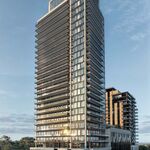www.thestar.com/News/article/168610
From The Star:
How TTC will pay its way
The commission plans to dispose of properties around subways that it deems either surplus or prime for development
January 07, 2007
Kenneth Kidd
It would not spring to mind as a natural building site, much less one for an eight-storey condominium complex. There's the irregular shape, for starters – a property that resembles a pizza slice, with a narrow tongue extending out beyond the crust.
The tongue, now home to a couple of tennis courts, is really not so much land as a concrete roof covering the above-ground Bloor-Danforth subway line as it enters High Park Station from Runnymede to the west.
Temporary fencing already surrounds the site, enclosing a dumpster, a portable toilet and two mobile homes-cum-construction trailers. Out front, big signs from Monarch Development Corp. announce the looming arrival of "Twenty Gothic," which will actually straddle the subway tracks.
Unusual, perhaps, but it may be the first of many such developments as the Toronto Transit Commission embarks on what amounts to the Great TTC Lawn Sale – a bid to dispose of more than a dozen properties it now deems either surplus or prime for development.
They range from the small, like the lawn in front of Rosedale subway station, to the four-acre site of the old Lansdowne Garage, recently demolished, between Bloor St. and Dupont Ave.
This won't be the first time the TTC has sold property. In the past decade, the transit authority has unloaded several small parcels of land, mostly old trolley bus loops. And some other properties have been the subject of (mostly failed) development proposals in the past.
But Councillor Adam Giambrone, the TTC's 29-year-old incoming chair, now wants the sell-off to proceed in earnest. In December, TTC commissioners even formed a special committee to propel the disposal – a committee that will meet for the first time later this month.
"This committee will probably meet monthly," says Giambrone. "The idea of the committee is not just to talk about it, but to drive the process forward, like a working group.
"If you say there's a problem around zoning, this committee needs to work through those issues, tackle them head on and resolve them to the extent they're resolvable, compromise where compromise is needed and just generally push the whole file forward."
At first blush, there could be much demand for these properties. "You can't make more land, so anything they can make available is already enticing for developers and investors," says Raymond Wong, national director of research with CB Richard Ellis Ltd.
"There's tremendous demand for sites, especially infill sites or brownfield sites in the city. Infill development over the last 10 years in Toronto has been quite strong."
When Canadian Tire Corp. recently sold off surplus land at Leslie St. and Sheppard Ave., for instance, the price worked out to $3.8 million per acre.
Public policy has also helped fuel demand. With as many as 150,000 people moving into the Greater Toronto Area each year, both provincial policy and the city's official plan call for intensive residential development around subway stations and major transportation corridors – a way of curtailing urban sprawl.
But while Wong says, "the potential is there" for the TTC's coffers to get a boost, he's not sure the sell-off will amount to anything like the giant windfall some councillors might have in their dreams.
It's not just the peculiarity of some sites, like having to build over top of a subway yard at Davisville station, that makes predicting prices difficult. (The High Park deal involved a land swap.) There's also the need, in many cases, for potential developers to accommodate existing and future TTC operations. The buses, after all, still need to get to the station.
Nor is raising immediate cash the sole aim for either the TTC or the city, notes Vincent Rodo, the commission's budget chief. "When we're trying to develop these properties, we've got several goals. One is, obviously, proper utilization of a public asset. You want density over subways. We're hoping to get ridership out of it."
There's also elevated property tax revenue for the city in future. But in many cases, a sale would mostly help defray the costs of something the TTC would have to do anyway, such as replacing the original bus terminal at Eglinton station, which had to be closed several years ago after engineers deemed it structurally unsound.
And that's along with all the usual hoops. "If you've got to do a planning study, a planning study can easily take a year-and-a-half, two years," says Rodo. "You've got to craft a (request for proposals) and go out for public meetings and make sure the development is in keeping with the community.
"You might even have an environmental assessment. You might have legal complications if there are easements and things of that nature."
All of which makes it difficult to predict how many properties may ultimately be sold, and how much cash might then flow to the TTC.
--------------------------------------------------------------------------------
But a deal already in the works at Islington station may provide a partial template. At that station, there is currently a bus terminal, a passenger pick-up and drop-off area and a commuter parking lot on a triangle-shaped piece of land. Mississauga buses now use Islington to connect with the subway, but the TTC bus terminal is aging and needs to be replaced within the next decade or so.
Enter SNC-Lavalin in a multi-layered deal effectively brokered by the TTC. The engineering firm is expected to pay around $8.1 million for what roughly amounts to the parking lot area, on which it plans to build its Ontario head office.
But that's just one aspect of a $58-million project that would see a new, inter-regional terminal built further west, at Kipling subway station. This would become the new subway connection for Mississauga buses, as well as the destination for Mississauga and GO buses operating on their own rights-of-way, or busways. Kipling is already home to a GO train station and funding, if approved, would come from Mississauga, GO and the province.
Back at Islington, meanwhile, the old bus terminal would then be replaced by a smaller facility that would handle only TTC vehicles. "The city would take the net proceeds from the SNC-Lavalin deal to help pay for the city's share of the [new] Islington terminal," says Rodo. "SNC-Lavalin is here today. It just gives you the opportunity to consider doing something today that you might not do for five years."
There are also long-term benefits. With the Islington deal, says Giambrone, "the estimated tax revenue is about $4 million a year and the TTC gets a new bus terminal out of it," says Giambrone.
"And we get an office tower basically sitting on top of a subway station.
"In this case, they've got up to 1,400 employees. If that drives transit ridership, it's an incredible boon to the system."
Other stations listed as possible development sites: Davisville, Eglinton, Finch, Greenwood, Lawrence, Leslie, Rosedale, Sheppard, Warden, Wilson and York Mills.
As Giambone puts it: "When you look at Rosedale, you sort of ask yourself, `wow, that lawn looks really nice, but is it the most appropriate site in terms of having that large open space?' That would seem to be the ideal place for some sort of residential [development]."
But at Rosedale and other stations bordering low-rise neighbourhoods, developers may also face fierce community opposition. In the late 1980s, for instance, a proposal to build an office tower over Rosedale station was ultimately rejected by the Ontario Municipal Board.
"It got turned down because the Rosedale area was kind of the gateway to the park and the ravine there," says Rodo. "You've just got to find out how to do a development that's in keeping with the community."








